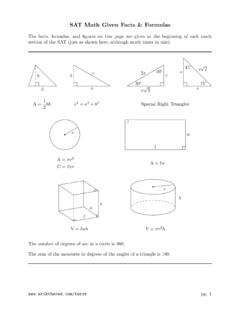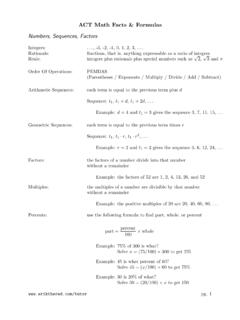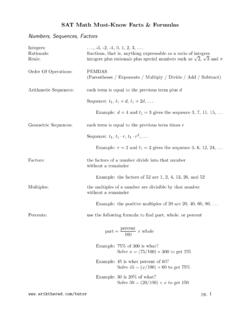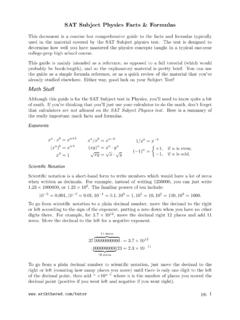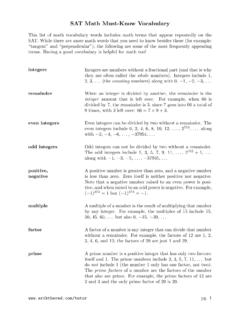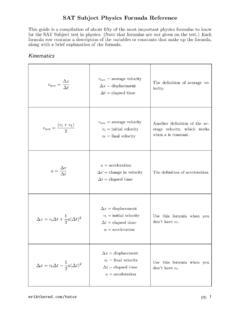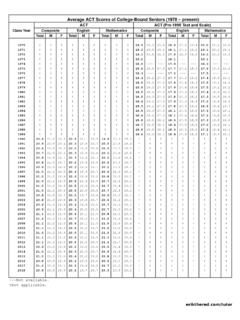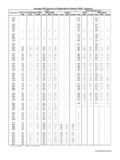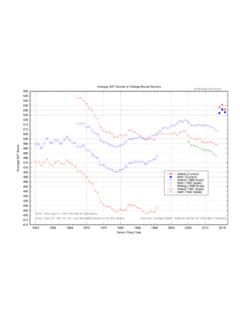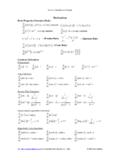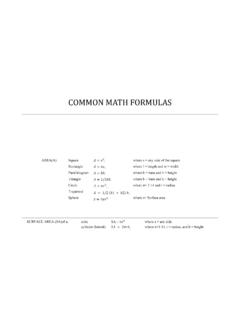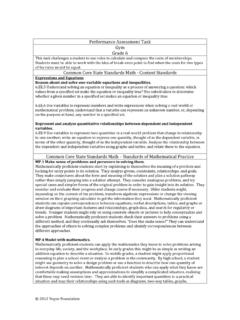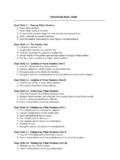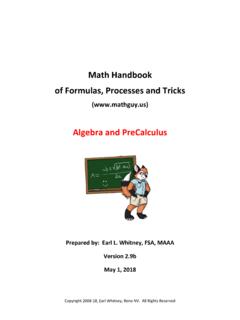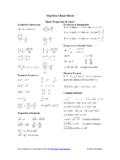Transcription of SAT Subject Math Level 2 Facts & Formulas …
1 SAT Subject math Level 2 Facts & Formulas Numbers, Sequences, Factors Integers: .. , -3, -2, -1, 0, 1, 2, 3, .. Reals: integers plus fractions, decimals, and irrationals ( 2, 3, , etc.). Order Of Operations: PEMDAS. (Parentheses / Exponents / Multiply / Divide / Add / Subtract). Arithmetic Sequences: each term is equal to the previous term plus d Sequence: t1 , t1 + d, t1 + 2d, .. The nth term is tn = t1 + (n 1)d Number of integers from in to im = im in + 1. Sum of n terms Sn = (n/2) (t1 + tn ). Geometric Sequences: each term is equal to the previous term times r Sequence: t1 , t1 r, t1 r 2 , .. The nth term is tn = t1 r n 1. Sum of n terms Sn = t1 (r n 1)/(r 1). Sum of infinite sequence (r < 1) is S = t1 /(1 r).
2 Prime Factorization: break up a number into prime factors (2, 3, 5, 7, 11, .. ). 200 = 4 50 = 2 2 2 5 5. 52 = 2 26 = 2 2 13. Greatest Common Factor: multiply common prime factors 200 = 2 2 2 5 5. 60 = 2 2 3 5. GCF(200, 60) = 2 2 5 = 20. Least Common Multiple: check multiples of the largest number LCM(200, 60): 200 (no), 400 (no), 600 (yes!). Percentages: use the following formula to find part, whole, or percent percent part = whole 100. pg. 1. SAT Subject math Level 2 Facts & Formulas Averages, Counting, Statistics, Probability sum of terms average =. number of terms total distance average speed =. total time sum = average (number of terms). mode = value in the list that appears most often median = middle value in the list (which must be sorted).
3 Example: median of {3, 10, 9, 27, 50} = 10. Example: median of {3, 9, 10, 27} = (9 + 10)/2 = Fundamental Counting Principle: If an event can happen in N ways, and another, independent event can happen in M ways, then both events together can happen in N M ways. (Extend this for three or more: N1 N2 N3 .. ). Permutations and Combinations: The number of permutations of n things is n Pn = n! The number of permutations of n things taken r at a time is n Pr = n!/(n r)! The number of permutations of n things, a of which are indistinguishable, b of which are indistinguishable, etc., is n Pn /(a! b! ..) = n!/(a! b! ..).. The number of combinations of n things taken r at a time is n Cr = n!/ (n r)! r! Probability: number of desired outcomes probability =.
4 Number of total outcomes The probability of two different events A and B both happening is P (A and B) = P (A) P (B), as long as the events are independent (not mutually exclusive). If the probability of event A happening is P (A), then the probability of event A not happening is P (not A) = 1 P (A). pg. 2. SAT Subject math Level 2 Facts & Formulas Logic (Optional): The statement event A implies event B is logically the same as not event B implies not event A . However, event A implies event B is not logically the same as event B implies event A . To see this, try an example, such as A = {it rains} and B = {the road is wet}. If it rains, then the road gets wet (A B); alternatively, if the road is not wet, it didn't rain (not B not A).
5 However, if the road is wet, it didn't necessarily rain (B 6 A). Powers, Exponents, Roots xa xb = xa+b xa /xb = xa b 1/xb = x b (xa )b = xa b (xy)a = xa y a . n +1, if n is even;. ( 1) =. 0. x =1 xy = x y 1, if n is odd.. If 0 < x < 1, then 0 < x3 < x2 < x < x< 3. x < 1. Factoring, Solving (x + a)(x + b) = x2 + (b + a)x + ab FOIL . a2 b2 = (a + b)(a b) Difference Of Squares . a2 + 2ab + b2 = (a + b)(a + b). a2 2ab + b2 = (a b)(a b). x2 + (b + a)x + ab = (x + a)(x + b) Reverse FOIL . You can use Reverse FOIL to factor a polynomial by thinking about two numbers a and b which add to the number in front of the x, and which multiply to give the constant. For example, to factor x2 + 5x + 6, the numbers add to 5 and multiply to 6, , a = 2 and b = 3, so that x2 + 5x + 6 = (x + 2)(x + 3).
6 To solve a quadratic such as x2 +bx+c = 0, first factor the left side to get (x+a)(x+b) = 0, then set each part in parentheses equal to zero. , x2 + 4x + 3 = (x + 3)(x + 1) = 0 so that x = 3 or x = 1. The solution to the quadratic equation ax2 + bx + c = 0 can always be found (if it exists). using the quadratic formula : . b b2 4ac x= . 2a Note that if b2 4ac < 0, then there is no solution to the equation. If b2 4ac = 0, there is exactly one solution, namely, x = b/2a. If b2 4ac > 0, there are two solutions to the equation. pg. 3. SAT Subject math Level 2 Facts & Formulas To solve two linear equations in x and y: use the first equation to substitute for a variable in the second. , suppose x + y = 3 and 4x y = 2.
7 The first equation gives y = 3 x, so the second equation becomes 4x (3 x) = 2 5x 3 = 2 x = 1, y = 2. Solving two linear equations in x and y is geometrically the same as finding where two lines intersect. In the example above, the lines intersect at the point (1, 2). Two parallel lines will have no solution, and two overlapping lines will have an infinite number of solutions. Functions A function is a rule to go from one number (x) to another number (y), usually written y = f (x). The set of possible values of x is called the domain of f (), and the corresponding set of possible values of y is called the range of f (). For any given value of x, there can only be one corresponding value y. Translations: The graph of y = f (x h) + k is the translation of the graph of y = f (x) by (h, k) units in the plane.
8 Absolute value: . +x, if x 0;. |x| =. x, if x < 0. |x| < n n < x < n |x| > n x < n or x > n Parabolas: A parabola parallel to the y-axis is given by y = ax2 + bx + c. If a > 0, the parabola opens up. If a < 0, the parabola opens down. The y-intercept is c, and the x-coordinate of the vertex is x = b/2a. Note that when x = b/2a, the y-value of the parabola is either a minimum (a > 0) or a maximum (a < 0). Ellipses: An ellipse is essentially a squashed circle. The equation of an ellipse centered on the origin which intersects the x-axis at ( a, 0) and the y-axis at (0, b) is: x2 y2. + = 1. a2 b2. pg. 4. SAT Subject math Level 2 Facts & Formulas Hyperbolas (Optional): A hyperbola looks like two elongated parabolas pointed away from one another.
9 The equation of a hyperbola centered on the origin, pointing down the positive and negative x-axes, and which intersects the x-axis at ( a, 0) is: x2 y2. = 1. a2 b2. Compound Functions: A function can be applied directly to the y-value of another function. This is usually written with one function inside the parentheses of another function. For example: f (g(x)) means: apply g to x first, then apply f to the result g(f (x)) means: apply f to x first, then apply g to the result f (x)g(x) means: apply f to x first, then apply g to x, then multiply the results For example, if f (x) = 3x 2 and g(x) = x2 , then f (g(3)) = f (32 ) = f (9) = 3 9 2 = 25. Inverse Functions: Since a function f () is a rule to go from one number (x) to another number (y), an inverse function f 1 () can be defined as a rule to go from the number y back to the number x.
10 In other words, if y = f (x), then x = f 1 (y). To get the inverse function, substitute y for f (x), solve for x in terms of y, and substitute f 1 (y) for x. For example, if f (x) = 2x + 6, then x = (y 6)/2 so that f 1 (y) = y/2 3. Note that the function f (), given x = 1, returns y = 8, and that f 1 (y), given y = 8, returns x = 1. Usually, even inverse functions are written in terms of x, so the final step is to substitute x for y. In the above example, this gives f 1 (x) = x/2 3. A quick recipe to find the inverse of f (x) is: substitute y for f (x), interchange y and x, solve for y, and replace y with f 1 (x). Two Facts about inverse functions: 1) their graphs are symmetric about the line y = x;. and 2) if one of the functions is a line with slope m, the other is a line with slope 1/m.
